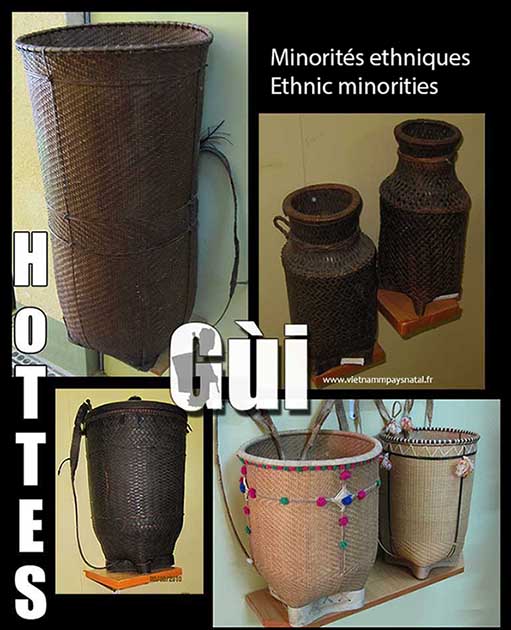Analogue à la palanche des Vietnamiens, la hotte munie des bretelles accrochées aux épaules est très utilisée par les minorités ethniques, en particulier celles de la cordillère annamitique (Trường Sơn) pour transporter couramment les objets usuels (sarcloir, serpe etc … selon la saison ), les produits de la cueillette, des bûches ou de la viande dans leur vie journalière.
Les hottes sont de diverses tailles. La petite est employée pour la décoration et pour le détachement des grains des épis de riz tandis que la grande sert à contenir du riz ou du maïs. Certaines hottes au tressage clairsemé en bambou ou en rotin sont prévues pour transporter des bûches. D’autres sont destinées à contenir des calebasses d’eau recueillie d’une source de la montagne. Les Bahnar possèdent des hottes aplaties collées au dos tandis que les Ede se servent des hottes à quatre pieds qu’ils peuvent déposer par terre pour une pause avant d’entamer la traversée de la rivière. Parfois, on trouve des hottes à couvercle. Celles-ci sont destinées à contenir des objets précieux ou des vêtements. Certaines hottes prévues pour le dot de mariage témoignent non seulement d’un tressage extrêmement laborieux mais aussi d’une beauté originale illustrée par des couleurs et des motifs décoratifs traditionnels. Cela reflète aussi l’amour et les sentiments que le jeune marié souhaiterait adresser avec tendresse à la jeune femme de sa vie car le tressage est toujours le domaine réservé aux hommes.
Similar to the Vietnamese palanche, the basket with two shoulders straps is very used by ethnic minorities, in particular those of the Anamitic Cordillera (Trường Sơn) for transporting commonly everyday objects (sarclois, billhook etc … depending on the season), food products gathered, logs or meat in their daily life.
The baskets are of various sizes. The small basket is used for the decoration and detachment of rice grains with ears while the big basket serves to contain rice or maize. Some bamboo or rattan baskets in sparse braiding are used for transporting wood logs. Others are intended to contain calabashes of water collected from a mountain source.
The Bahnar possess the baskets very flattened and glued on the back while the Ede use the four-leg baskets which they can remove on the ground for a pause before starting the river crossing. Sometimes, one finds the baskets with cover. These ones are intended to contain precious objects or clothing.
Some baskets reserved for the dot of marriage testify not only of a weaving extremely laborious but also an original beauty shown by the colors and traditional decorative motifs. It also reflects the love and the feelings the young husband would send with tenderness to the young woman of his life because the weaving is always the domain belonging to men.
